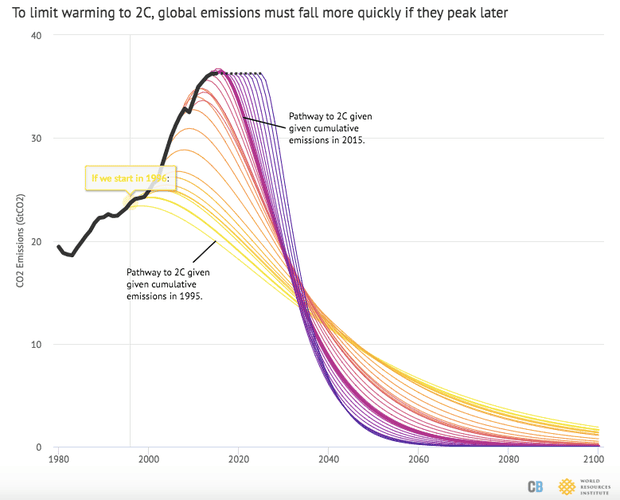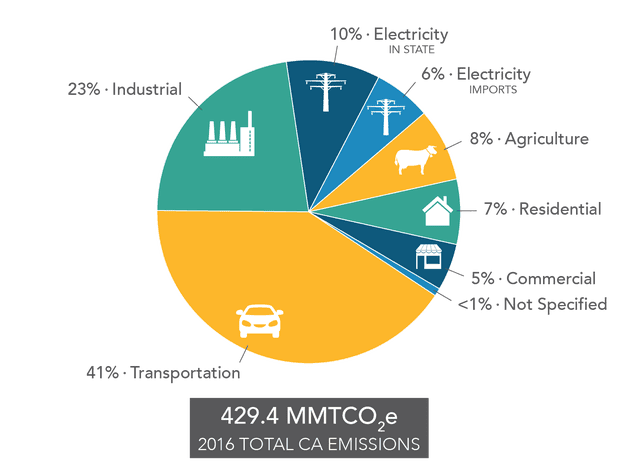California plans to show the world how to meet the Paris climate target
Posted on 17 September 2018 by dana1981
Last week, California Governor Jerry Brown signed State Senator and US Senate candidate Kevin de León’s SB 100, which mandates that the state obtain all of its electricity from zero-carbon sources by 2045. That in itself was a big deal, but Brown didn’t stop there; he also issued an executive order calling for the entire California economy to become carbon-neutral by 2045. That’s a huge deal.
In order to stay below the Paris climate threshold of 2°C global warming above pre-industrial temperatures, humanity must become carbon-neutral by around 2060 or 2070. If California can meet Brown’s target, it will be providing the rest of the world a blueprint for meeting the Paris target. As the world’s fifth-largest economy, California can provide a powerful roadmap for others to follow.

Global emission reduction trajectories associated with a 66% chance of avoiding more than 2°C warming by starting year. Solid black line shows historical emissions, while dashed black line shows emissions constant at 2016 levels. Data and chart design from Robbie Andrew at CICERO and the Global Carbon Project. Illustration: Carbon Brief
Brown’s executive order directs the California Air Resources Board (CARB) to work with relevant state agencies to develop a framework for implementation and accounting of progress toward statewide carbon neutrality. While state agencies can figure out a plan to achieve carbon neutrality, the state legislature will have to pass laws to implement that plan.
California has been all-in on tackling climate change, as its carbon cap and trade system and SB 100 illustrate, but Californians will have to keep electing climate realists to state office in order to make the dream of carbon neutrality a reality.
Carbon-free electricity is just a start
SB 100 tackles the electricity sector, but because California has long been transitioning toward clean energy, electricity now only accounts for 16% of the state’s greenhouse gas emissions. Transportation accounts for the biggest chunk at 41%. Brown has been pushing for a transition to electric cars, signing another executive order earlier this year setting a goal of 5m EVs on the road by 2030, and several bills last week to help expand their use.

California greenhouse gas emissions by sector. Illustration: California Air Resources Board
While California has the most EVs on the road today (both total and per capita) of any state, they still only account for 5% of new car sales, with 380,000 sold so far. Accelerating that transition toward EVs is crucial for meeting the carbon neutrality goal, and it’s the main reason why California is fighting the Trump administration’s efforts to freeze fuel efficiency standards and take away the state’s ability to set its own.
The industrial sector accounts for another 23% of California’s greenhouse gas emissions. About half of that comes from the petroleum industry – predominantly from drilling for oil and natural gas, as well as oil refining. California is the fourth-largest oil producing state. The Trump administration wants to increase that number and is contemplating opening 1.6 million acres in California held by the Bureau of Land Management to fracking and oil drilling. But a wiser future president could revoke those drilling leases on federal lands, and California could ban drilling and fracking on state lands. That’s a bridge too far for Jerry Brown, and protesters have been criticizing him for it, but it’s easy to imagine a future governor taking this step.
Agriculture and forestry account for another 8% of California’s greenhouse gas emissions. The state is already launching a Healthy Soils Initiative to increase carbon sequestration via farming. For example, one pilot project is monitoring how much carbon will be stored by clover planted between trees at an almond orchard. The University of California at Davis is also conducting experiments to evaluate how changing livestock feed can reduce methane emissions from cattle.
Another 7% comes from the residential sector, most of which is due to burning natural gas for heating and cooking. But stoves, hot water heaters, and heating units can be replaced by electric appliances powered by California’s increasingly carbon-free energy. Last week, Brown also signed a bill directing CARB to study ways of cutting carbon pollution from residential and commercial buildings.































 Arguments
Arguments






























Recommended supplemental reading,,,
California Had Its Own Climate Summit. Now What? by Brad Plumer, Climate, New York Times, Sep 15, 2018
Helpful Leadership examples are important.
A more important development would be effective penalties for 'supposed winners/leaders' who act in harmful/unhelpful ways. A particularly important development would be legal penalties for anyone who can be shown to be developing or disseminating misleading marketing that would create unjustified popular support for undeserving smaller worldview private interests (interests of a sub-set of humanity in a shorter time-frame - their personal desires in their lifetime), interests that are contrary to achieving the larger worldview public interests of the Sustainable Development Goals (all of humanity now and into the distant future). And the expectations of helpfulness should be more strictly enforced the higher the status of the person behaving questionably (higher status, wealth or influence in business or politics).
Ultimately, achieving good results requires everyone who genuinely wants to be helpful to be able to restrict and correct the harmful unsustainable developments that can be encouraged and defended in competitions to appear to be superior to others, especially when acceptability is judged by measures of profitability or popularity. As examples, the damage done to Lake Erie, the River Thames, or the ozone layer, was not rapidly corrected by the people who benefited from the damage done self-correcting their behaviour based on thoroughly and carefully improving their awareness and understanding of the impacts of their activity. In fact, there are always delays in curtailing the harmful activity. Others usually identify the unacceptability of the behaviour. And the damage done is never fully corrected. And the ones who benefited most from the damage done are very rarely the ones who end up cleaning up the results of the damaging unsustainable actions they benefited from.
The required development and corrections, like achieving the Sustainable Development Goals, cannot be expected to be accomplished by charitable actions of a portion of the population, especially if others remain freer to continue to try to benefit by making a bigger problem for the charitable to try to overcome. Misleading marketing that tempts people to desire a smaller worldview is harmful, and should be effectively penalized to discourage it.
The Dance of development by the freer actions of people is predictable. It can be easily understood to motivate the development of fundamentally unsustainable and harmful behaviour. Predictable results are produced when 'pursuit of primitive human desires for impressions of superiority relative to others (small worldview)' are not effectively limited by the 'modern human ability to compassionately and thoughtfully pursue improved awareness and understanding to help develop a sustainable better future for humanity (larger worldview)':
The future of humanity clearly requires improved awareness and understanding of what is going on. It needs Helpful Altruistic (large worldview) people to be able to effectively govern and limit the behaviour of harmful (small worldview) people as the helpful also try to educate the entire population in order to reduce the number of people who require external governance, reducing the need for 'bigger government'.
I am sort of a reverse-Conservative. I like the idea of smaller government. But I do not support the belief that smaller government will develop a better society. I understand the need for the general population to be better educated, including corrections, in order to reduce the need for larger government. A better-informed and more considerate population is required to make freer Political and Economic Democracies successful (sustainable).
I think the true impact of Animal Agriculture is closer to 50% of global emissions when you account for desertification, deforestation, eutrophication and acidification of the oceans, wild animal habitat loss, the raising of massive animal feed products and fresh water use by Animal Ag. Seems to me that California isn't dealing with these issues and other external costs associated with Animal Ag. Does anyone tracking along with skepticalscience.com have a scientifically defensible number for Animal Ag's contribution to GGEs? Is California's 18% defensible?
[DB] Please take all discussion of Animal Agriculture to this thread. Thanks.
Off-topic snipped. Any responses should be placed at the link, not here.
2° C = DISASTER | James Hansen
1° C = DANGEROUS CLIMATE CHANGE | James Hansen
5 of 13 Tipping Points start at 1.5° – 2° C = Cascading Runaway Heating. | Hans Schellnhuber
The latest permafrost wetlands study show those emissions are newly considered a tipping point, which means the Paris climate budget is outdated.
WHAT THIS MEANS IS WE HAVE A 66% CHANCE OF HITTING DISASTER
A 44% CHANCE OF HITTING SOMETHING WORSE THAN DISASTER.
[DB] All-Caps usage stricken, per the Comments Policy.
Unlike the simple example of positive feedback we learned in high school, the increase from every round of feedback gets smaller and smaller, in the case of the enhanced greenhouse effect. It is a significant factor in the overall warming, but it does NOT lead to a "runaway" trajectory for temperature. Place any further remarks on that topic at that thread, please, and not here.
In 20 years 80% of all cars will be gas or diesel. Get real.
Here are all the climate/energy charts you need in one spot.
https://lokisrevengeblog.wordpress.com/2018/05/28/charting-collapse/
[JH] Sloganeering snipped. Argumentative snide remark snipped.
Please note that posting comments here at SkS is a privilege, not a right. This privilege can be rescinded if the posting individual treats adherence to the Comments Policy as optional, rather than the mandatory condition of participating in this online forum.
Please take the time to review the policy and ensure future comments are in full compliance with it. Thanks for your understanding and compliance in this matter.
BeezelyBilly, maybe you would consider adding this graph to your collection?
The following is to reinforce the point in my comment@2 that charitable (or helpful) behavior by a portion of the population will not be enough to solve a problem that has been created by the developed socioeconomic systems.
Imagine if the corrections of what was being done to Lake Erie, the River Thames, or the ozone layer only happened through the choices made by the consuming public:
There would have been no meaningful corrections without parties external to the marketplace improving awareness and understanding and being able to Impose restrictions and limits on the damaging unsustainable activities.
And regarding the overall actions of California leadership. Are they also going to eliminate the unsustainable rate of removal of water from aquifers that is fueling their unsustainable agriculture operations? Are they going to end the 'grandfather permissions' for old dirtier fossil fuel activity to continue to operate uncorrected?
Recommended supplemental reading:
Jerry Brown Made Climate Change His Issue. Now, He’s Not Sure How Much Politicians Can Do. by Somini Sengupta, Climate, New York Times, Sep 18, 2018
Suggested supplemental readings:
Spotted at the Climate Summit: Republican Mayors by Liz Enochs, City Lab, Sep 19, 2018
Climate Summit Highlights States’ Commitment to Combating Global Warming by Russell Fortmeyer, Architectural Record, Sep 20, 2018